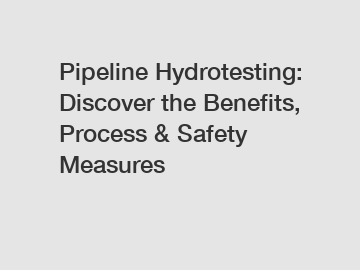Pipeline Hydrotesting: Discover the Benefits, Process & Safety Measures
Pipeline Hydrotesting: Discover the Benefits, Process & Safety Measures.
Pipeline hydrotesting is a crucial process in the oil and gas industry. It involves testing the integrity and reliability of pipelines before they are put into service. In this article, we will delve into the benefits of pipeline hydrotesting, the process involved, and the safety measures taken to ensure its success.
The main benefit of pipeline hydrotesting is that it helps identify and mitigate potential issues that could lead to leaks or failures in the pipeline. This process involves filling the pipeline with water or another suitable test medium and pressurizing it to a predetermined level. By doing so, any weaknesses or defects in the pipeline can be identified, allowing for necessary repairs or replacements to be made before it is put into operation.

The process of pipeline hydrotesting is carried out in several steps. First, the pipeline is carefully prepared by ensuring it is clean and free of any foreign materials. Once the preparation is complete, the pipeline is filled with water or another test medium. The pressure is gradually increased to the desired level and held for a specified period of time. During this period, any leaks or failures are carefully monitored, and the necessary repairs or replacements are made.
The safety measures taken during pipeline hydrotesting are crucial to ensure the protection of workers and the environment. Before carrying out the test, all personnel involved are trained in the proper handling of equipment and materials. They are also equipped with the necessary personal protective equipment (PPE) to minimize the risks associated with the high-pressure environment.
In addition to safety equipment, monitoring systems are put in place to continuously measure and record pressure levels during the hydrotesting process. This allows for prompt action to be taken in the event of abnormal pressure fluctuations or leaks. Emergency response procedures are also established and communicated to all personnel involved, ensuring a quick and effective response in case of any emergencies.
The significance of pipeline hydrotesting cannot be underestimated. By detecting potential issues before the pipeline is put into service, it helps prevent costly and dangerous failures. It contributes to the overall safety and reliability of the pipeline system, which is critical for transporting oil and gas over long distances.
Furthermore, pipeline hydrotesting is a requirement mandated by regulatory bodies in many countries. Compliance with these regulations ensures that the pipeline meets certain standards for safety and performance. Failure to comply can result in significant penalties and reputational damage to the company.
In conclusion, pipeline hydrotesting is a vital process in the oil and gas industry. It helps identify potential issues, ensures the safety of workers and the environment, and ensures compliance with regulatory standards. By understanding the benefits, process, and safety measures involved, we can appreciate the importance of pipeline hydrotesting in maintaining the integrity and reliability of pipeline systems.
If you are looking for more details, kindly visit Hydrotesting of Pipeline, Flange Management Service China supplier, Oil Flushing System.

Comments